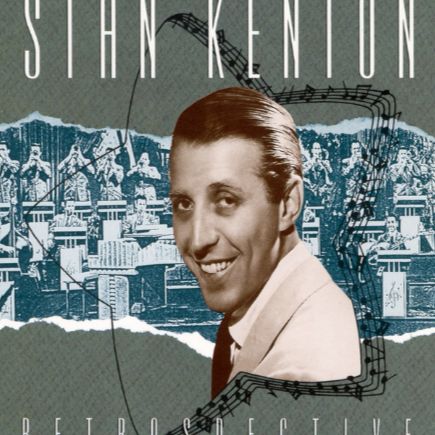Stan Kenton: l’esprit symphonique du jazz d’après-guerre
Pianiste, compositeur, arrangeur et chef d’orchestre, Stan Kenton demeure l’une des figures les plus ambitieuses et controversées du jazz moderne. Héritier du swing et pionnier du jazz orchestral à tendance symphonique, il a su bâtir un langage musical d’une ampleur inédite, oscillant entre puissance rythmique, expérimentation harmonique et recherche d’une forme d’élévation esthétique. Influencé par le pianiste Earl Hines et le saxophoniste-arrangeur Benny Carter, Stan Kenton a très tôt compris que le jazz pouvait être plus qu’un art du rythme: une véritable architecture sonore.
Dès les années 1940, il dirige des formations d’une grande originalité, privilégiant les harmonies nouvelles au swing traditionnel. Avec son Artistry in Rhythm Orchestra, il propose une musique exigeante et audacieuse, marquée par des orchestrations complexes et un goût pour les contrastes. Stan Kenton devient ainsi un représentant avant-gardiste du style cool, bien avant qu’il ne soit popularisé par Miles Davis et Gil Evans.
En 1944, il engage la chanteuse Anita O’Day, rompant les conventions raciales de l’époque: leur collaboration propulse son orchestre au sommet du succès et l’impose comme le meilleur big band blanc du moment, rivalisant avec celui de Woody Herman.
Son ambition artistique le pousse ensuite à explorer la fusion entre jazz et musique classique européenne. Entre 1947 et 1956, il enregistre une série d’albums novateurs tels que Innovations in Modern Music ou New Concepts of Artistry in Rhythm, véritables laboratoires sonores où se croisent contrepoints, dissonances et rythmes afro-cubains. Ce Kenton Sound — massif, raffiné et cinématographique — construit un pont entre la tradition afro-américaine et les influences modernes de Stravinsky, Ravel ou Bartók.
En 1953, Kenton et son orchestre entreprennent une tournée européenne triomphale: acclamés à Paris, ils atteignent l’apothéose à Dublin, où les foules envahissent les rues pour saluer le chef et ses musiciens. Certains de ses ensembles comptent jusqu’à quarante instrumentistes, dont des solistes de haut niveau comme Lee Konitz, Maynard Ferguson ou Art Pepper, qui y trouvent un terrain d’expérimentation unique.
Stan Kenton: el espíritu sinfónico del jazz de posguerra
Pianista, compositor, arreglista y director de orquesta, Stan Kenton sigue siendo una de las figuras más ambiciosas y controvertidas del jazz moderno. Heredero del swing y pionero del jazz orquestal de tendencia sinfónica, supo construir un lenguaje musical de una amplitud inédita, oscilando entre la fuerza rítmica, la experimentación armónica y la búsqueda de una forma de elevación estética. Influido por el pianista Earl Hines y el saxofonista y arreglista Benny Carter, Kenton comprendió muy pronto que el jazz podía ser más que un arte del ritmo: una auténtica arquitectura sonora.
Desde los años cuarenta, dirigió formaciones de gran originalidad, privilegiando las nuevas armonías frente al swing tradicional. Con su Artistry in Rhythm Orchestra, propuso una música exigente y audaz, marcada por orquestaciones complejas y un gusto por los contrastes. Stan Kenton se convirtió así en un representante de vanguardia del estilo cool, mucho antes de que Miles Davis y Gil Evans lo popularizaran.
En 1944 contrató a la cantante Anita O’Day, rompiendo las convenciones raciales de la época: su colaboración llevó a la orquesta a la cima del éxito, imponiéndose como la mejor big band blanca del momento, rivalizando con la de Woody Herman.
Su ambición artística lo llevó a explorar la fusión entre el jazz y la música clásica europea. Entre 1947 y 1956 grabó una serie de álbumes innovadores, como Innovations in Modern Music o New Concepts of Artistry in Rhythm, verdaderos laboratorios sonoros donde se cruzan contrapuntos, disonancias y ritmos afrocubanos. Este Kenton Sound —masivo, refinado y cinematográfico— construyó un puente entre la tradición afroamericana y las influencias modernas de Stravinsky, Ravel o Bartók.
En 1953, Kenton y su orquesta emprendieron una gira triunfal por Europa: aclamados en París, alcanzaron la apoteosis en Dublín, donde las multitudes salieron a las calles para celebrar al director y a sus músicos. Algunas de sus formaciones contaban con hasta cuarenta instrumentistas, entre ellos solistas de alto nivel como Lee Konitz, Maynard Ferguson y Art Pepper, que encontraron en su orquesta un terreno de experimentación único.
Stan Kenton: lo spirito sinfonico del jazz del dopoguerra
Pianista, compositore, arrangiatore e direttore d’orchestra, Stan Kenton rimane una delle figure più ambiziose e controverse del jazz moderno. Erede dello swing e pioniere del jazz orchestrale di tendenza sinfonica, seppe costruire un linguaggio musicale di ampiezza inedita, oscillando tra potenza ritmica, sperimentazione armonica e ricerca di un’elevazione estetica. Influenzato dal pianista Earl Hines e dal sassofonista e arrangiatore Benny Carter, Kenton comprese presto che il jazz poteva essere più di un’arte del ritmo: una vera e propria architettura sonora.
Fin dagli anni Quaranta diresse formazioni di grande originalità, privilegiando le nuove armonie rispetto allo swing tradizionale. Con la sua Artistry in Rhythm Orchestra propose una musica esigente e audace, caratterizzata da orchestrazioni complesse e da un gusto marcato per i contrasti. Stan Kenton divenne così un rappresentante d’avanguardia dello stile cool, molto prima che Miles Davis e Gil Evans lo rendessero popolare.
Nel 1944 scritturò la cantante Anita O’Day, rompendo le convenzioni razziali dell’epoca: la loro collaborazione portò l’orchestra al vertice del successo, imponendosi come la migliore big band bianca del momento, al pari di quella di Woody Herman.
La sua ambizione artistica lo spinse poi a esplorare la fusione tra jazz e musica classica europea. Tra il 1947 e il 1956 incise una serie di album innovativi, come Innovations in Modern Music e New Concepts of Artistry in Rhythm, autentici laboratori sonori in cui si intrecciano contrappunti, dissonanze e ritmi afro-cubani. Questo Kenton Sound —imponente, raffinato e cinematografico— costruì un ponte tra la tradizione afroamericana e le influenze moderne di Stravinsky, Ravel e Bartók.
Nel 1953 Kenton e la sua orchestra intrapresero una trionfale tournée europea: acclamati a Parigi, raggiunsero l’apoteosi a Dublino, dove la folla invase le strade per salutare il direttore e i suoi musicisti. Alcuni dei suoi ensemble contavano fino a quaranta strumentisti, tra cui solisti di altissimo livello come Lee Konitz, Maynard Ferguson e Art Pepper, che trovarono nella sua orchestra un terreno di sperimentazione unico.
Stan Kenton: the symphonic spirit of postwar jazz
Pianist, composer, arranger, and bandleader, Stan Kenton remains one of the most ambitious and controversial figures in modern jazz. Heir to the swing era and pioneer of orchestral jazz with symphonic ambitions, he built a musical language of unprecedented scope—balancing rhythmic power, harmonic experimentation, and a constant quest for artistic elevation. Influenced by pianist Earl Hines and saxophonist-arranger Benny Carter, Kenton quickly realized that jazz could be more than an art of rhythm: it could be a true architecture of sound.
From the 1940s onward, he led highly original ensembles that favored bold harmonic innovation over traditional swing. With his Artistry in Rhythm Orchestra, he offered a demanding and daring form of music marked by complex orchestrations and a taste for contrast. Kenton became an avant-garde figure of the cool style, long before Miles Davis and Gil Evans popularized it.
In 1944, he hired singer Anita O’Day, breaking the racial conventions of the time—their collaboration brought his orchestra to the height of success, establishing it as the finest white big band of the era, rivaling Woody Herman’s.
His artistic ambition later led him to explore the fusion of jazz and European classical music. Between 1947 and 1956, he recorded a series of groundbreaking albums such as Innovations in Modern Music and New Concepts of Artistry in Rhythm, true sonic laboratories where counterpoint, dissonance, and Afro-Cuban rhythms converged. This Kenton Sound—massive, refined, and cinematic—built a bridge between African American jazz traditions and the modern influences of Stravinsky, Ravel, and Bartók.
In 1953, Kenton and his orchestra embarked on a triumphant European tour: acclaimed in Paris, they reached their peak in Dublin, where crowds filled the streets to greet the maestro and his musicians. Some of his ensembles included up to forty players, featuring top-level soloists such as Lee Konitz, Maynard Ferguson, and Art Pepper, who found in his orchestra a unique ground for experimentation.


